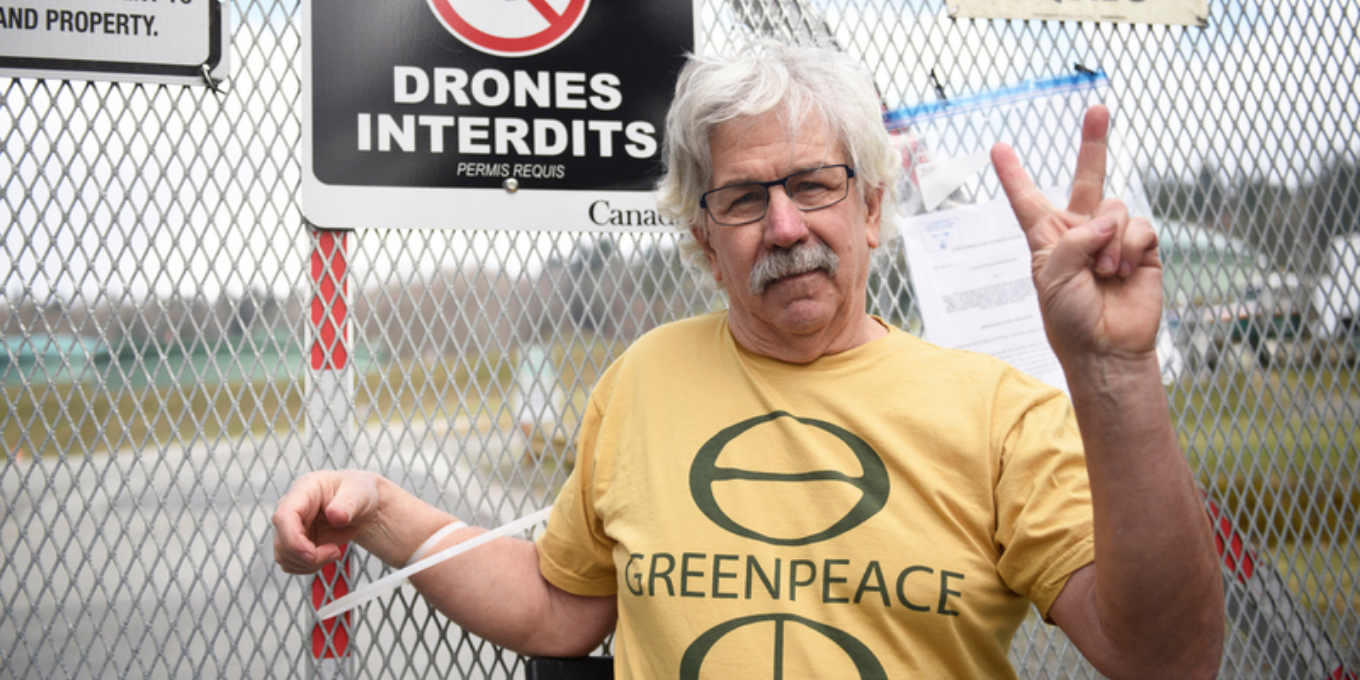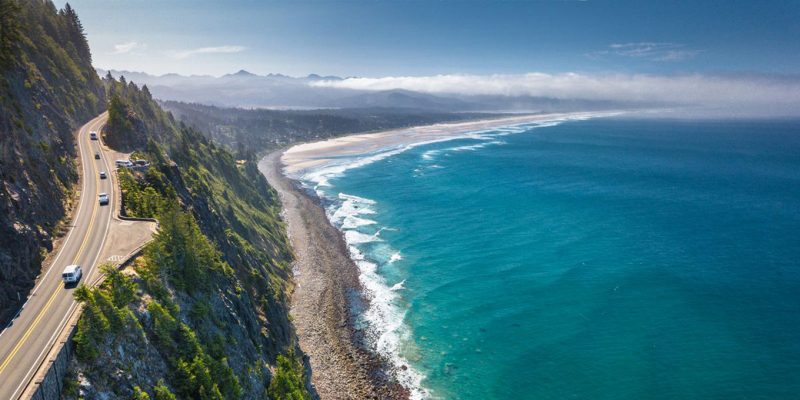Society
50 Years of Greenpeace: Q&A With Co-Founder Rex Weyler
Greenpeace just turned 50 and to mark 50 years of hope in action, of ordinary people doing extraordinary things and command the unprecedented change that is needed to save our planet, we are shining a spotlight on Greenpeace co-founder Rex Weyler.
by : Dina Ni- Sep 16th, 2021

Greenpeace
With Greenpeace’s 50th anniversary on the horizon, I was asked to host a series of virtual “mailbag” calls connecting activists across generations and regions. The outpouring of interest — and questions — from those at Greenpeace today was moving.
While I could not address all the great questions and comments in one article or one call, here is the first batch. These are my thoughts and ideas. Someone else might have different ideas. I make no claim to arriving at complete and definitive answers to these questions.
When did you start caring about nature?
“I was fortunate as a young child to live in natural settings, with rivers, forests, hills, and ocean to explore. However, as a child, I didn’t know how vulnerable all this was. Later, I witnessed pristine natural settings obliterated for shopping malls, highways, and parking lots. Rachel Carson’s Silent Spring taught me more about the crisis, and in 1969 when the Cuyahoga River in Ohio caught on fire from pollution, I realized the urgency of the crisis. From Gregory Bateson, Arne Naess, the Taoist writers, and my Indigenous friends, I began to learn a deeper respect for how to think and live the way nature works. I recently wrote about this for Greenpeace.”
What did you envision Greenpeace to become? Did you envision a global organization with millions of supporters in 55 countries?
“Sort of. In the 1970s, we set out to create a global ecology movement, which did not exist at the time, and we expected that the movement would expand around the world. In the beginning, I think most of us were more interested in a global movement than in a global organization. We wanted people to rise up everywhere and defend biodiversity and vulnerable ecosystems. Friends of the Earth and other organizations arose at the same time. As Greenpeace offices sprang up all over the world, to maintain clear communications about our work, we had to create a global structure, and thus we created Greenpeace International in Amsterdam in 1979. The movement is strong enough now, that it will continue with or without any single organization. Fridays for Future and Extinction Rebellion are examples of how the movement evolves. This is more or less what I hoped would happen.”
 Participants of the first Greenpeace international meeting gather on the roof patio of the Greenpeace Nederland office in Amsterdam. © Greenpeace / Rex Weyler
Participants of the first Greenpeace international meeting gather on the roof patio of the Greenpeace Nederland office in Amsterdam. © Greenpeace / Rex WeylerWhat is your fondest memory?
“There are many fond memories, and most are linked to the camaraderie of working with people to achieve something larger, more important than ourselves: Sailing on the fish boat in 1975, at night under the stars as if adrift in the universe, playing music, learning maritime skills, the day we found the whalers, the shared euphoria, the shared heartbreak at witnessing the slaughter, the shared satisfaction when our pictures and story circled the globe, and the feeling that we had achieved something significant.”
What is the biggest risk that you took?
“I felt most at risk the first time we actually maneuvered our Zodiacs between the whales and the whalers in 1975. During the previous two years of organizing this campaign, and two months at sea looking for the whaling fleets, I had not thought about the consequences of what we planned. However, once I stood in the bow of the Zodiac, with the whales in front of us and a harpoon boat behind, it occurred to me that if we were hit by one of these 200-pound exploding harpoons, we would be instantly killed. I suddenly felt a chilling tremor of fear, but with no alternative but to stay in place. That remains the most frightening moment of my Greenpeace experience.”
 Greenpeace Zodiac approaching Russian whaling fleet, the Dalniy Vostok and harpoon boats. North Pacific. © Greenpeace / Rex Weyler
Greenpeace Zodiac approaching Russian whaling fleet, the Dalniy Vostok and harpoon boats. North Pacific. © Greenpeace / Rex Weyler“Nothing survives alone. We only survive in relationship with the living matrix. That is where I look for hope”
What advice would you give to your younger self about activism?
“I would advise my younger self to pay more attention to the relationships, internal and external, to be more aware of others’ motivations and intentions. I believe I was sometimes naive and perhaps too tolerant of big egos. I would also advise more modesty in the face of the challenge we set for ourselves. Confidence is helpful, but overconfidence is not. I was unaware of how easily our stated values and visions for an ecological society could be misunderstood and even subverted. I would also advise more boldness and less compromise in certain cases. We often made compromises to appease other factions in society and in the environmental movement. Sometimes those compromises might have been helpful, but in some cases, we may have allowed our message to be blunted.”
What was the best campaign action you were ever involved with?
“The 1970s whale campaign was probably the most successful because it achieved two significant goals: It led to the 1982 whaling moratorium and many populations of whales began to recover. We also had the intention that this campaign would help launch an ecology movement, which it did.
One of my favorite campaign actions, however, was our “test blockade” of a supertanker. In 1981, as we were working in our Vancouver office, Rod Marining read in the newspaper that in three days, an oil tanker was going to enter the Salish Sea between Seattle and Vancouver, loaded with water, as a “test” to demonstrate how easily an oil tanker could maneuver in these inside waters, promoting an oil port. We were discussing what we might do when our office manager Julie McMaster said casually, ‘You should do a test blockade.’”
 The Greenpeace ship Norsal during the “Test Blockade” of oil tanker B. T. San Diego in Juan de Fuca Strait between Canada and the US. © Greenpeace / Rex Weyler
The Greenpeace ship Norsal during the “Test Blockade” of oil tanker B. T. San Diego in Juan de Fuca Strait between Canada and the US. © Greenpeace / Rex WeylerThis made us laugh, and we thought: This is perfect! We promptly announced to the media that we were going to do a “test blockade” of the oil tanker test run. We knew we were onto something when the reporters laughed. We phoned our friend Dennis Feroce, who agreed to pilot his boat, The Meander, to take us to the entrance of Juan de Fuca Strait, where the tanker would have to enter. Three days later, we sat ready in the water with our Zodiacs and a small flotilla of sailboats, as television camera crews flew overhead in helicopters. We stopped the tanker dead in the water, film and photographs went all over the US and Canada, and we got arrested by the US coast guard and taken to jail in Everett, north of Seattle. The media followed us, as we told the police that it was “just a test.” We made jokes about testing the handcuffs, testing the jail, and the police also laughed. Everyone was on our side. When an officer brought us our meal (fast food burgers), she dropped the bag on the table in the cell and said “test this.” The entire campaign was hilarious, and the oil port never got built. This is one of my favorite campaigns because we pulled it off in three days, everyone had fun, and the idea came not from a seasoned activist or a campaign committee, but from our unassuming office manager, Julie.
What campaign would you do that would truly shift the needle now?
“To shift the needle in social action, one has to be creative and do something that is not expected. When environmental groups do what everyone expects them to do, nothing changes. For example, regarding global warming, I would suggest don’t do the predictable thing and go to the next climate conference. Flip the script. Boycott the climate conference. Explain why: Because the next conference in Glasgow in October will be the 34th international climate conference since the first one in 1979, and these conferences have achieved nothing significant.
Thirty-four climate conferences in 42 years, and during that time human carbon emissions have doubled. Atmospheric CO2 levels have gone from 337 parts per million (ppm) to 420 ppm; the oceans are choked with acidification, the coral beds are dying, forests are burning, and the world’s politicians are burning jet fuel to twiddle their thumbs at these climate meetings. I would suggest: Stop validating this nonsense. Boycott. Organize the ecology groups to boycott together, and state the reasons. Hold your own separate meetings regionally and on the internet. Denounce the phoney and hollow promises by governments. Go instead to every major seaside city on Earth and paint the future waterline on buildings to depict sea rise after the Antarctic and Greenland ice melts. Give people a new picture, not the failing routine.
The great social movements of history that have actually changed things have been able to find a way to do the unexpected, to blow up the prevailing paradigm, to make people think in new ways.”
Is the pandemic just nature fighting back because it is being damaged so severely?
“The pandemic is linked to human overshoot, our occupation of wild habitats, our destruction of biodiversity, our growth and consumption beyond the capacity and limits of the global ecosystems. So, yes, the conditions for the swift transmission of this pandemic are created by human activity. However, nature does not really “fight back.” Evolution does not appear to have goals or preferences, and does not hold grudges. Nevertheless, pandemics will likely continue to be one consequence of neglecting our ecological crisis.”
What is one thing you wish Greenpeace today would do that it isn’t doing?
“I don’t assume that Greenpeace can or should do everything that needs to be done. I know from experience that people project onto Greenpeace the responsibility for every environmental urgency, an impossible expectation for a single organization. Thus, I think of this question more as ‘What do I wish the environmental movement would do that it isn’t doing?’”
I wish the ecology/environmental movement was more realistic about our real, fundamental crisis: Ecological overshoot and the conditions that create it, namely: unfettered growth. Overshoot is natural. Most successful species overshoot their habitats, a pack of wolves will overshoot the capacity of a watershed, algae will overshoot the capacity of a lake, and we can see in our own gardens how everything grows into its neighbours, tangling and pushing the limits of space and resources. Natural evolution teaches all species how to grow, reproduce, and consume, but evolution does not teach species when to stop, when to restrain itself.
I wish the ecology movement would more directly address the fact that humanity has overshot Earth’s capacity. Calculated estimates range from about 50% overshoot (Footprint Network) to 100% or more. The significant point is that all pathways out of overshoot — for any species anywhere, no exceptions — involve contraction: The wolves die back until their game recovers; the algae die back to the limit of available nutrients; plants push back on each other until they reach a new dynamic homeostasis. We make a mistake if we behave as if humanity does not have to also get smaller in numbers and consumption, the two issues we tend to avoid. Government, industry, and even some environmental groups focus on new technologies and a presumed “green growth,” avoiding the inevitable contraction of human economic activity, numbers, and consumption.
Addressing the frivolous, wasteful consumption of the rich is a good place to start, but not the full story. To actually reverse overshoot, we also need to address the global economic system of capitalism, which requires unrealistic, endless growth; we need to address equitable ways to reverse human population growth (women’s rights and accessible contraception); and we need to be realistic about what is required to clean up our technologies. I would like to see the environmental movement be more active and serious about all three of these necessary steps to reversing overshoot.”
What do movements and organizations that sustain over time have in common? What is essential for longevity and resilience?
“There is a huge difference between a movement and an organization. The movements for peace, civil rights, women’s rights, and others have survived for centuries because they have a robust constituency and clear goals that have not yet been fully achieved. Similarly, the ecology movement will likely endure long into the future.
Organizations, on the other hand, can come and go. Social organizations gain support and prominence because they address an issue that people care about and they appear effective. I say “appear” because an organization may endure, through reputation and self-promotion, even if it becomes less effective than its supporters believe. For an effective social organization to endure, however, requires a constituency that believes the organization plays an essential role, that the leadership has integrity, and that it can achieve genuine change.
Typically, successful organizations arise because some group of people have a creative idea about how to address a problem about which the public is generally aware. Creativity is essential in the birth and growth of an organization. However, as an organization grows and becomes more structured, it is possible that creativity is stifled rather than encouraged. Maintaining creativity is a key quality of successful organizations. By definition, there is no formula for creativity. Rather than attempt to formalize creativity, successful organizations learn to create the conditions for creativity, to overcome bureaucratic roles, and allow new ideas to flourish at every level of the organization.”
Where do you find hope?
“This is a popular question these days, I believe because so many of us feel the concern about humanity’s future. We meet discouraging obstacles, resistance, subversion, and indifference, so we naturally seek hopefulness. Hope is a good frame of mind, because it opens paths to action, but hope is not a strategy. To solve problems, one must deeply understand the problem, the conditions, and appreciate the larger systems and forces at work. Delusional hope is definitely not helpful.
Humanity exists now in a tremendous bind. The powerful and wealthy have plundered the Earth to enrich a few, while billions live on the edge of starvation. Meanwhile, species diversity plummets, the atmosphere fills with carbon-dioxide, the oceans turn acidic and are choked with plastic, and we face myriad ecological tragedies. I do not find hope in political conferences, governments, corporations, nor in appeals to the general good of humanity. In my experience, most people are decent and fair, but greed, fear, and ignorance can create chaos and harm.
I find hope in nature itself, in the wild world, in the power of life to create new conditions, in the shared learning and co-evolution of all nature. This is where, I believe, humanity has to turn. We are not solving our problems with conferences, technologies, space travel, or economic growth. These delusions create more problems. I believe we have to rejoin the ecological community. We have to become apprentices to nature and learn how the natural world actually endures and survives as a living system. I believe we have to shed our human pride and re-align ourselves with all our relatives, with the systems and processes of the entire natural Earth. I’m with the Taoists and certain Indigenous teachers on this: We have to learn to respect our Mother Earth, the source of all life.
Nothing survives alone. We only survive in relationship with the living matrix. That is where I look for hope.”
This story originally appeared on Greenpeace Canada
Read more:
Understanding Extreme Weather Can Help Soothe Our Eco-Anxiety
8 Small, Daily Changes You Can Make to Reduce Your Ecological Footprint
How You Can Reduce Your Plastic Waste With This Effortless Switch
Newsletter
Join our mailing list for the latest and biggest in fashion trends, beauty, culture and celebrity.
Read Next

Fashion
H&M's Latest Designer Collab With Rokh Just Dropped (And It's So Good)
We chatted with the emerging designer about the collaboration, his favourite pieces and more.
by : Melissa Fejtek- Apr 18th, 2024

Culture
5 Toronto Restaurants to Celebrate Mother’s Day
Treat your mom right with a meal at any of these amazing restaurants.
by : Rebecca Gao- Apr 18th, 2024

Culture
This University Elevates Women to New Professional Heights
You shouldn’t have to pause your life to move forward in your career.
by : ELLE Canada- Apr 16th, 2024



